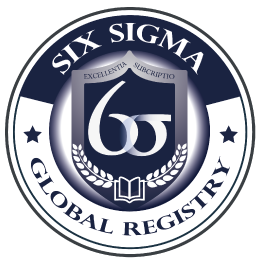Six Sigma Certification
Professionals and those interested in Six Sigma ask Acosixsigma about the requirements to obtain Six Sigma certification. How can I be certified? Where can I get certified? Is Six Sigma certification transferable if I change companies? This article will help answer these and other questions about Six Sigma certification that have confused many professionals for years.
As required before obtaining a driver's license, Six Sigma certification demonstrates appropriate subject matter knowledge by passing a written proficiency test, and demonstrating knowledge in real cases. Materials and training can be purchased from any Six Sigma training and consulting company. Companies usually obtain in-house training sections that have different levels (green belt, black belt, master black belt, etc.)
The written exam can be given by the training company or the company that hires the training company. Typically, companies new to Six Sigma choose to use the training company's exam. Companies that have done their own in-house training for many years (such as Motorola, GE or Sunbeam) have created and administered their own written exam.
After a professional has completed their training, they must complete one or two projects and demonstrate competence in applying the concepts learned in the training. This is where certification companies diverge, because this part of certification is the most confusing and undefined. Some organizations require the candidate to complete one project if they are a Green Belt or two projects if they are a Black Belt or Master Black Belt; others require less or more. Also, there is no standard that determines what is pass or fail the competencies demonstrated by the individual.
So, what can we get from the certification? Any valid certification requires training, involves a written exam and demonstrates the ability to use the methodology in real problems. The specifics around each of these requirements vary from company to company. Will this be standardized? Probably, but not for the next six to twelve months in this author's opinion.
There is no single body designated to provide Six Sigma certification. Almost all companies specializing in Six Sigma training and consulting provide this certification. Why is this? Because individuals and companies are spending a great deal of money, amounts that have exceeded $30,000 per individual, to train, and the training companies feel they must have something for the individual to show off their skills. For this reason, certification has become popular as an added value for consulting companies because it allows different levels to be differentiated.
Quality certification titles such as Certified Quality Manager (CQM), Certified Quality Engineer (CQE), and Certified Quality Auditor (CQA) can only be obtained through the American Society for Quality (ASQ) – because they are the only certifying body for these titles. No other company or entity offers these certifications because it would be difficult to convince individuals and companies that the certification has the same value as the ASQ certification.
There are many reasons why ASQ did not automatically become the source of Six Sigma certification for Green Belts, Black Belts and Master Black Belts as it has for CQM, CQE and CQA. First, ASQ began offering certification around the year 2000, although Six Sigma has been popular since the mid-1990s. Second, the methodology was originally proprietary to Motorola (although most if not all of the individual tools that make up Six Sigma are in the public domain), and it was not apparent how much of an impact Six Sigma was going to have on the business world until the late 1990s. Finally, there have been complaints among quality professionals that ASQ is a slow-moving organization, and that has tried to control the evolution of Six Sigma, which has created a barrier to adoption in the industry and by companies
The reasons for Six Sigma certification are the same as for any other certification:
- Demonstrate knowledge and experience in the subject.
- Increase employment opportunity
- Potential to increase your salary
Ultimately, certification is a professional decision that can only be made by the individual. In some cases, it is a requirement in order to advance within an organization or to get a better job. In some companies it is required that each employee be trained in Green or Black Belt and that they also be certified if they want to be promoted within the organization. In other cases, Six Sigma certification will demonstrate your energy and intent to be a leader in your organization.
The answer is yes and no. Just as you get a driver's license in one country, you can drive in other countries, but the laws vary from country to country, requiring an individual to learn the specific laws for that country. Six Sigma certification is similar in that certain requirements or variations exist between companies implementing the Six Sigma methodology. Some companies may require re-certification and many encourage their employees to re-certify each year to demonstrate their competencies.
Usually a company will value an individual's certification if it is obtained from a leading Six Sigma company such as Motorola, GE, Allied Signal, and Sunbeam. Likewise, obtaining the certification through a training or consulting company will add value to the certification. Nowadays having the training without obtaining the certification has a minimum value for the companies.
Leave us your data to advise you!
FAQ
According to the Body of Knowledge (BOK) of the American Society for Quality (ASQ) and the international certification programs recognized by Motorola University and the International Society for Six Sigma Certifications, the minimum hour number of the Six Sigma program is: There are a number of Six Sigma programs that are widely marketed and apply only a fraction of the BOK for each level. Acosixsigma is recognized for the large amount of curricular content that applies to all types of industry. For example, the estimated time for a Black Belt certification course is 120 hours, not including additional time allocated to a Six Sigma project. Other providers offer Black Belt training courses totaling 90 hours and Green Belt courses advertised at 56 hours. Therefore the variability in class hours obviously serves as a warning for interested companies to carefully check the subjects when taking a particular course against the established criteria for certification.
A Lean/Kaizen/Blitz Event is an intense effort where the team applies specific Lean approaches to reduce waste, defects, and cycle time and to implement improvements in a particular process or department.
Lean Six Sigma is an integrated set of methodologies that encompasses both Lean and Six Sigma concepts. It combines two powerful toolsets to address all aspects of quality, cost, and delivery. Both sets of methodologies have a customer and quality focus and are based on continuous improvement, which allows them to be very complementary.
Lean focuses on offering competitively priced products and services by eliminating waste and its drivers, while Six Sigma focuses on minimizing and reducing process variation that causes nonconformities.
Lean Six Sigma combines the strength and rigor of Six Sigma and data-driven analysis with the simple tools of Lean to eliminate waste and its drivers. The combination of the two methods provides a more robust set of tools for organizations to apply to solve problems, using the tools and techniques that best suit the specific problem at hand. Rather than the traditional independent use of tools, Lean Six Sigma combines Lean approaches into Six Sigma through the DMAIC (Define, Measure, Analyze, Improve and Control) method, as well as allowing Lean approaches to be used on their own. in the DMAIC model.
Process improvement is necessary for the performance of an organization that does not meet customer requirements. Lean Six Sigma offers a comprehensive set of tools, techniques, and approaches to enable an organization to gather customer requirements, analyze existing performance against those requirements, implement solutions to address performance gaps, and maintain best-in-class status. The tools and techniques used are the most appropriate for the specific problem at hand.

